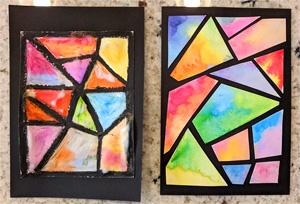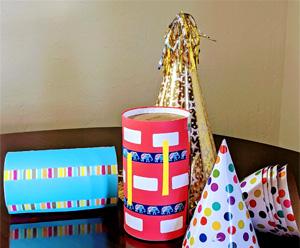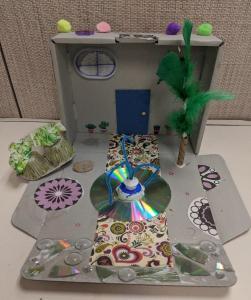

Supplies:
- Watercolors
- Cup of water
- Paint brush
- Pencil
- Black crayon or oil pastel
- White watercolor paper or heavy cardstock
- Black cardstock or construction paper
- White school glue
- Glue stick
- Optional: popsicle stick or toothpicks to spread glue
Directions:
Oil Pastel & Glue Watercolor Stained Glass
- Lightly draw a stained-glass design with pencil on your white paper.
- Outline the stained-glass design with black pastel or crayon.
- Working section by section, wet a section of your design with a paintbrush and plain water. Dab watercolor in that section. Feel free to mix colors.
- Repeat for each section of your design, wetting the paper first, before adding paint.
- Let your design dry.
- Outline each section of your design with glue, inside the black lines.
- Spread glue in each section.
- Let your project dry.
- Finished!
Collage-style Stained Glass
- You will need a sheet of black cardstock or construction paper to be the background of your final project.
- Lightly draw a stained-glass design with pencil on your white watercolor paper.
- Working section by section, wet a section of your design with a paintbrush and plain water. Dab watercolor in that section. Feel free to mix colors.
- Repeat for each section of your design, wetting the paper first, before adding paint.
- Let your design dry.
- Cut out each section of your design.
- Lay out your cutout pieces on the black paper.
- Once you like the arrangement, glue down each piece to the black paper with a glue stick.
- Finished!
Watch this project at: https://www.youtube.com/watch?v=vu2UYBh1G3w&list=PLxg4vmuqrAtckvp9eurSG…

SUPPLIES:
- Coffee or Oats Can (empty)
- Thick Rubber Bands
- Medium / Large Hex Nut
- Paper Clips (Large and Small)
- Nail / Hammer
- Screwdriver
- Tape
- Pencil (*optional)
- Colored paper, tape, and stickers for decoration (*optional)
DIRECTIONS:
- Poke a hole in the center of the coffee / oats can top and bottom using a hammer and nail.
- Enlarge the hole by tapping a screwdriver through the hole with a hammer.
- Tape your rubber band to the top of the large nut. Make sure it’s centered and very secure! (*Depending on the size of your can, you may need to knot two bands together so that there’s not too much tension on them.)
- Open up a small paper clip and thread it through one loop of the rubber band. This will be your “needle.”
- From the inside of the can, very carefully “thread” the paper clip (with the rubber band attached) through the hole in the bottom of the can. There may be sharp edges, so be careful! Slip a large paper clip through the rubber band loop to secure it in place. Remove the paper clip “needle.”
- Place the paper clip “needle” through the remaining loop of the rubber band and carefully pull it through the hole in the coffee / oats can lid. (If the hex nut has moved closer to one side of the rubber band, move it back so that it hangs on the center of the can when stretched.) (*If necessary, place the pencil between the lid and can to temporarily hold everything in place.)
- Slip another large paper clip through the rubber band loop to secure it in place. Remove the paper clip “needle” and the pencil. Make sure the lid is attached securely to the can!
- If you’d like, decorate your can with colored paper, tape, and stickers. Time for testing! On a flat, smooth surface, gently roll your can away from you. Just before it mysteriously begins to roll back, summon your super powers and call the can back to you. A little “hocus pocus” or “abracadabra” will convince your audience of the magic.
*Troubleshooting : Be sure to use thick rubber bands that will store up enough energy to cause the can to roll back to you. Also check that your hex nut is not touching the side of the can. If it is, use a shorter rubber band or knot your rubber band. If just one band is too short and tight, knot two rubber bands together. You can also thread an extra hex nut onto the outside top and bottom of the can as spacers if your rubber band(s) are too long. Experiment and you’ll get it just right.
Watch this project at: https://youtu.be/Hk1OthEqSfs

Supplies:
- Boxes
- Paper
- Any random materials – bottle caps, beads, egg cartons, cds, etc.
- Scissors
- Adhesive – glue, stickers, etc.
Directions:
Use these found, recycled items to make your own creation.
Watch this project at: https://youtu.be/Zc1PUl5WCSw


